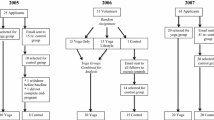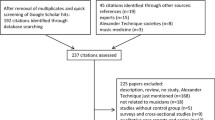Abstract
Yoga and meditation can alleviate stress, anxiety, mood disturbance, and musculoskeletal problems, and can enhance cognitive and physical performance. Professional musicians experience high levels of stress, performance anxiety, and debilitating performance-related musculoskeletal disorders (PRMDs). The goal of this controlled study was to evaluate the benefits of yoga and meditation for musicians. Young adult professional musicians who volunteered to participate in a 2-month program of yoga and meditation were randomized to a yoga lifestyle intervention group (n = 15) or to a group practicing yoga and meditation only (n = 15). Additional musicians were recruited to a no-practice control group (n = 15). Both yoga groups attended three Kripalu Yoga or meditation classes each week. The yoga lifestyle group also experienced weekly group practice and discussion sessions as part of their more immersive treatment. All participants completed baseline and end-program self-report questionnaires that evaluated music performance anxiety, mood, PRMDs, perceived stress, and sleep quality; many participants later completed a 1-year followup assessment using the same questionnaires. Both yoga groups showed a trend towards less music performance anxiety and significantly less general anxiety/tension, depression, and anger at end-program relative to controls, but showed no changes in PRMDs, stress, or sleep. Similar results in the two yoga groups, despite psychosocial differences in their interventions, suggest that the yoga and meditation techniques themselves may have mediated the improvements. Our results suggest that yoga and meditation techniques can reduce performance anxiety and mood disturbance in young professional musicians.


Similar content being viewed by others
References
Ackermann, B. J., & Adams, R. D. (2004). Perceptions of causes of performance-related injuries by music health experts and injured violinists. Perceptual and Motor Skills, 99, 669–678.
Ackermann, B., Adams, R., & Marshall, E. (2002). Strength or endurance training for undergraduate music majors at a university? Medical Problems of Performing Artists, 17, 33–41.
Bejjani, F. J., Kaye, G. M., & Benham, M. (1996). Musculoskeletal and neuromuscular conditions of instrumental musicians. Archives of Physical Medicine and Rehabilitation, 77, 406–413.
Birk, L. (2004). Pharmacotherapy for performance anxiety disorders: Occasionally useful but typically contraindicated. Journal of Clinical Psychology, 60, 867–879.
Brandfonbrener, A. G., & Kjelland, J. M. (2002). Music medicine. In R. Parncutt & G. E. McPherson (Eds.), The science and psychology of music performance: Creative strategies for teaching and learning (pp. 83–96). Oxford: Oxford University Press.
Buysse, D. J., Reynolds, C. F., Monk, T. H., Berman, S. R., & Kupfer, D. J. (1989). The Pittsburgh Sleep Quality Index: A new instrument for psychiatric practice and research. Psychiatry Research, 28, 193–213.
Chang, J. C., Midlarsky, E., & Lin, P. (2003). The effects of meditation on music performance anxiety. Medical Problems of Performing Artists, 18, 126–130.
Clark, D. B. (1989). Performance-related medical and psychological disorders in instrumental musicians. Annals of Behavioral Medicine, 11, 28–34.
Cohen, S., & Williamson, G. (1988). Perceived stress in a probability sample of the United States. In S. Spacapam & S. Oskamp (Eds.), The social psychology of health: Claremont symposium on applied social psychology. Newbury Park, CA: Sage.
Cox, W. J., & Kenardy, J. (1993). Performance anxiety, social phobia, and setting effects in instrumental music students. Journal of Anxiety Disorders, 7, 49–60.
Faulds, R. (2006). Kripalu Yoga: A guide to practice on and off the mat. New York: Bantam.
Fehm, L., & Schmidt, K. (2006). Performance anxiety in gifted adolescent musicians. Journal of Anxiety Disorders, 20, 98–109.
Green, J. A., Chamagne, P., & Tubiana, R. (2000). Prevention. In R. Tubiana & P. Camadio (Eds.), Medical problems of the instrumentalist musician (pp. 531–557). London: Martin Dunitz.
Harinath, K., Malhotra, A. S., Pal, K., Prasad, R., Kumar, R., Kain, T. C., et al. (2004). Effects of Hatha yoga and Omkar meditation on cardiorespiratory performance, psychologic profile, and melatonin secretion. Journal of Alternative and Complementary Medicine, 10, 261–268.
Heinrichs, C. (2000). Yoga für musiker: Die psycho-physischen belastungen des orchestermusikers unter dem aspekt des möglichen ausgleichs durch yoga. Musikphysiologie und Musikermedizin, 7, 55.
Hogg, K. (2001, August). Strike a pose: How guitarists use Hatha yoga to improve posture, flexibility, focus, and stamina. Acoustic Guitar, (104).
Jabusch, H. C., Muller, S. V., & Altenmuller, E. (2004). Anxiety in musicians with focal dystonia and those with chronic pain. Movement Disorders, 19, 1169–1175.
Kaspersen, M., & Gotestam, K. G. (2002). A survey of music performance anxiety among Norwegian music students. European Journal of Psychiatry, 16, 69–80.
Kenny, D. T. (2005). A systematic review of treatments for music performance anxiety. Anxiety Stress and Coping, 18, 183–208.
Kenny, D. T., Davis, P., & Oates, J. (2004). Music performance anxiety and occupational stress amongst opera chorus artists and their relationship with state and trait anxiety and perfectionism. Journal of Anxiety Disorders, 18, 757–777.
Kenny, D. T., & Osborne, M. S. (2006). Music performance anxiety: New insights from young musicians. Advances in Cognitive Psychology, 2, 103–112.
Kesselring, J. (2006). Music performance anxiety. In E. Altenmuller, M. Wiesendanger, & J. Kesselring (Eds.), Music, motor control and the brain (pp. 309–318). New York: Oxford University Press.
Kessler, R. C., McGonagle, K. A., Zhao, S., & Nelson, C. B. (1994). Lifetime and 12-month prevalence of DSM-III–R psychiatric disorders in the United States: Results from the National Comorbidity Study. Archives of General Psychiatry, 51, 8–19.
Khalsa, S. B. S. (2004). Yoga as a therapeutic intervention: A bibliometric analysis of published research studies. Indian Journal of Physiology and Pharmacology, 48, 269–285.
Khalsa, S. B. S., & Cope, S. (2006). Effects of a yoga lifestyle intervention on performance-related characteristics of musicians: A preliminary study. Medical Science Monitor, 12, CR325–CR331.
Kim, Y. (2005). Combined treatment of improvisation and desensitization to alleviate music performance anxiety in female college pianists: A pilot study. Medical Problems of Performing Artists, 20, 17–24.
Kirkwood, G., Rampes, H., Tuffrey, V., Richardson, J., & Pilkington, K. (2005). Yoga for anxiety: A systematic review of the research evidence. British Journal of Sports Medicine, 39, 884–891.
Langendoerfer, F., Hodapp, V., Kreutz, G., & Bongard, S. (2006). Personality and performance anxiety among professional orchestra musicians. Journal of Individual Differences, 27, 162–171.
Lin, P., Chang, J., Zemon, V., & Midlarsky, E. (2007). Silent illumination: A study on Chan (Zen) meditation, anxiety, and music performance quality. Psychology of Music, 36, 139–155.
Malathi, A., Damodaran, A., Shah, N., Krishnamurthy, G., Namjoshi, P., & Ghodke, S. (1998). Psychophysiological changes at the time of examination in medical students before and after the practice of yoga and relaxation. Indian Journal of Psychiatry, 40, 35–40.
Manjunath, N. K., & Telles, S. (2001). Improved performance in the Tower of London test following yoga. Indian Journal of Physiology and Pharmacology, 45, 351–354.
Manjunath, N. K., & Telles, S. (2004). Spatial and verbal memory test scores following yoga and fine arts camps for school children. Indian Journal of Physiology and Pharmacology, 48, 353–356.
McGinnis, A. M., & Milling, L. S. (2005). Psychological treatment of musical performance anxiety: Current status and future directions. Psychotherapy: Theory, Research, Practice, Training, 42, 357–373.
McNair, D. M., Lorr, M., & Droppleman, L. F. (1992). POMS manual: Profile of mood states. San Diego, CA: Edits.
Medoff, L. E. (1999). The importance of movement education in the training of young violinists. Medical Problems of Performing Artists, 14, 210–219.
Michalsen, A., Grossman, P., Acil, A., Langhorst, J., Ludtke, R., Esch, T., et al. (2005). Rapid stress reduction and anxiolysis among distressed women as a consequence of a three-month intensive yoga program. Medical Science Monitor, 11, CR555–CR561.
Middlestadt, S. E., & Fishbein, M. (1988). Health and occupational correlates of perceived occupational stress in symphony orchestra musicians. Journal of Occupational Medicine, 30, 687–692.
Miller, S. R., & Chesky, K. (2004). The multidimensional anxiety theory: An assessment of and relationships between intensity and direction of cognitive anxiety, somatic anxiety, and self-confidence over multiple performance requirements among college music majors. Medical Problems of Performing Artists, 19, 12–20.
Montello, L. (1997). Arts medicine editorial. International Journal of Arts Medicine, 5, 41–42.
Osborne, M. S., & Franklin, J. (2002). Cognitive processes in music performance anxiety. Australian Journal of Psychology, 54, 86–93.
Parasuraman, S., & Purohit, Y. S. (2000). Distress and boredom among orchestra musicians: The two faces of stress. Journal of Occupational Health Psychology, 5, 74–83.
Parry, C. W. (2000). Clinical approaches. In R. Tubiana & P. Camadio (Eds.), Medical problems of the instrumentalist musician (pp. 203–218). London: Martin Dunitz.
Powell, D. H. (2004). Treating individuals with debilitating performance anxiety: An introduction. Journal of Clinical Psychology, 60, 801–808.
Ray, U. S., Mukhopadhyaya, S., Purkayastha, S. S., Asnani, V., Tomer, O. S., Prashad, R., et al. (2001). Effect of yogic exercises on physical and mental health of young fellowship course trainees. Indian Journal of Physiology and Pharmacology, 45, 37–53.
Reitman, A. D. (2001). The effects of music-assisted coping systematic desensitization on music performance anxiety. Medical Problems of Performing Artists, 16, 115–125.
Shapter, L. (2000, November/December). Injury prevention and healing through yoga: How yoga can alleviate—and prevent—the aches and pains of string playing. Strings, (90).
Sinden, L. M. (1999). Music performance anxiety: Contributions of perfectionism, coping style, self-efficacy, and self-esteem. Thesis/Dissertation, Arizona State University.
Smith, A. M., Maragos, A., & Van Dyke, A. (2000). Psychology of the musician. In R. Tubiana & P. Camadio (Eds.), Medical problems of the instrumentalist musician (pp. 135–170). London: Martin Dunitz.
Soen, E. L. (2004). Yoga within the music studio. American Music Teacher, 54.1, 36–40.
Spahn, C., Richter, B., & Zschocke, I. (2002). Health attitudes, preventive behavior, and playing-related health problems among music students. Medical Problems of Performing Artists, 17, 22–28.
Tran, M. D., Holly, R. G., Lashbrook, J., & Amsterdam, E. A. (2001). Effects of Hatha Yoga practice on the health-related aspects of physical fitness. Preventive Cardiology, 4, 165–170.
Van Galen, G. P., Muller, M. L., Meulenbroek, R. G., & Van Gemmert, A. W. (2002). Forearm EMG response activity during motor performance in individuals prone to increased stress reactivity. American Journal of Industrial Medicine, 41, 406–419.
Wan, C. Y., & Huon, G. F. (2005). Performance degradation under pressure in music: An examination of attentional processes. Psychology of Music, 33, 155–172.
Weilerstein, D., & Neal, C. (2000). Violin technique. In R. Tubiana & P. Camadio (Eds.), Medical problems of the instrumentalist musician (pp. 573–594). London: Martin Dunitz.
Wilson, G. D., & Roland, D. (2002). Performance anxiety. In R. Parncutt & G. E. McPherson (Eds.), The science and psychology of music performance: Creative strategies for teaching and learning (pp. 47–61). Oxford: Oxford University Press.
Zaza, C. (1998). Playing-related musculoskeletal disorders in musicians: A systematic review of incidence and prevalence. Canadian Medical Association Journal, 158, 1019–1025.
Zaza, C., Charles, C., & Muszynski, A. (1998). The meaning of playing-related musculoskeletal disorders to classical musicians. Social Science and Medicine, 47, 2013–2023.
Zaza, C., & Farewell, V. T. (1997). Musicians’ playing-related musculoskeletal disorders: An examination of risk factors. American Journal of Industrial Medicine, 32, 292–300.
Acknowledgments
We gratefully acknowledge the contributions of Nancy Buttenheim, Jo Ann Levitt, and Larissa Hall Carlson who served as instructors for the yoga program, Ann Megyas who assisted many of the yoga and meditation classes, and Angela Wilson who supervised the followup data collection. We also thank the Kripalu Yoga Center and the Tanglewood Music Center for supporting this research. Sat Bir S. Khalsa has received consultant fees from the Kripalu Center for Yoga and Health.
Author information
Authors and Affiliations
Corresponding author
Rights and permissions
About this article
Cite this article
Khalsa, S.B.S., Shorter, S.M., Cope, S. et al. Yoga Ameliorates Performance Anxiety and Mood Disturbance in Young Professional Musicians. Appl Psychophysiol Biofeedback 34, 279–289 (2009). https://doi.org/10.1007/s10484-009-9103-4
Received:
Accepted:
Published:
Issue Date:
DOI: https://doi.org/10.1007/s10484-009-9103-4




